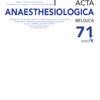Myocardial deformation imaging in anesthesia and perioperative medicine: a non systematic review
Strain ; left ventricle ; ejection fraction ; anesthesia
Published online: Mar 30 2020
Abstract
Measuring the systolic function of the left ventricle (LV) is essential in clinical practice. However, the complex organization of the myocardial fibers whose contraction results in the ejection of the stroke volume renders this assessment challenging. The ejection fraction of the left ventricle (LVEF) has long been the most popular measure of the systolic function of the left ventricle despite its numerous technical and non- technical limitations. More recently, the development of speckle-tracking echocardiography allowed the widespread adoption of myocardial deformation imaging indices such as the strain and the strain rate. Strain, and in particular, global longitudinal strain (GLS) has quickly gained popularity as an additional measure of the systolic function of the left ventricle. In comparison with the ejection fraction, GLS is easier to use, more reproducible, and more sensitive to mild changes in myocardial contractility. Strain is an interesting tool for diagnosis and prognostic stratification in both surgical and non-surgical patients. The purpose of this review is to describe the principles of strain use and to review its main applications, while focusing on the aspects relevant to the practice of anesthesia and intensive care medicine.
